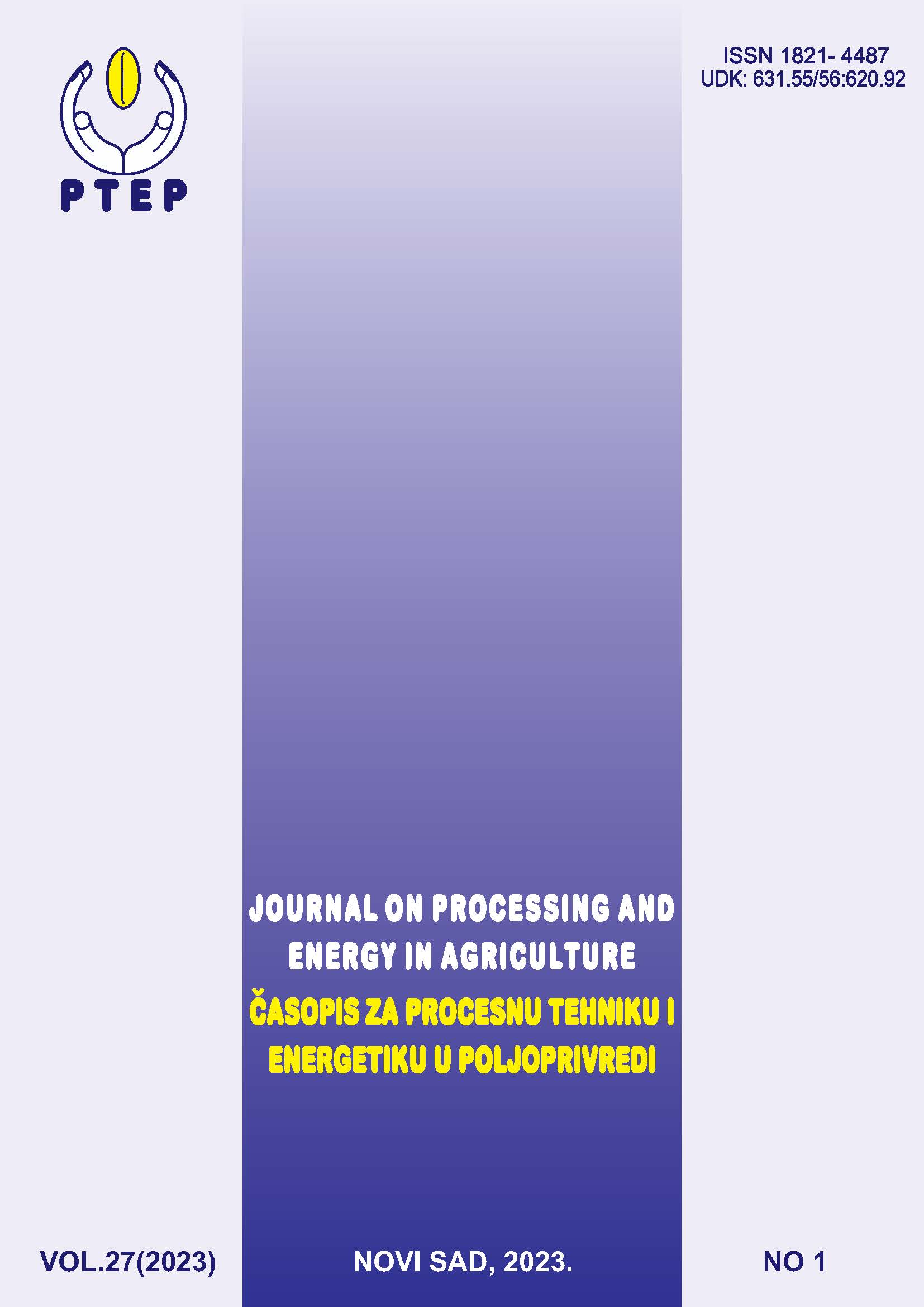VARIABILITY OF THE NUMBER AND WEIGHT OF 1000 SEEDS OF WEEDS PRESENT IN ALFALFA NATURAL SEEDS FROM DIFFERENT LOCATIONS IN SERBIA
Abstract
Alfalfa is the most significant perennial and multi-crop forage legume in Serbia. Seed production faces numerous problems, which causes high variability in seed yield. One of the problems in this production is the weed seeds that are in the natural alfalfa seed after harvesting. Minimum purity must be greater than 95 %, up to 2 % of other species are allowed, and up to 0.5 % of weeds, but no quarantine weeds such as dodder (Cuscuta spp.) and curly dock (Rumex spp.). Weed seeds were detected in natural alfalfa seeds: Sinapis arvensis L., Amaranthus retroflexus L., Rumex obtusifolius L., Cuscuta campestris Yunk., Rumex acetosella L., Plantago lanceolata L., Plantago major L., Rumex crispus L., Galium aparine L., Convolvus arvensis L. As expected, the variability of the number of weed seeds detected from the seed lots over three years was high: CV% = 14.78 for wild sorghum – S. halepense (L.) Pers. in the 2022, to CV% = 65.47 for ribwort plantain – P. lanceolata L in the 2020. For the mass of 1000 seeds of the examined weeds, the variability was determined from CV% = 5.869 for the ribwort plantain – P. lanceolata L. (year 2020), to CV% = 34.41 for yellow dock – R. crispus L. (year 2022).
References
REFERENCE
Ahmad, J.; Iqbal, A.; Mahmood, A.; Iqbal, M.A.; Khan, H.Z.; Abbas, R.N.; Akbar, N.; Maqsood, M. (2020). Effect of cutting management, seeding rates and sowing methods on seed yield of alfalfa (Medicage sativa L.). Pak. J. Bot., 52, 1449–1454.
Bolaños-Aguilar ED, Huyghe C, Ecalle C, Hacquet J, Julier B. (2002). Effect of Cultivar and Environment on Seed Yield in Alfalfa. Crop Sci. Jan., 42(1):45-50. doi: 10.2135/cropsci2002.4500. PMID: 11756252.
Đokić D., Terzić D., Rajičić V., Živković S., Oro V., Milenković J., Koprivica R. (2021). The influence of impurities in natural seeds of alfalfa and red clover on the seed cleaning process. Journal on Processing and Energy in Agriculture. Biblid: 1821-4487 (2021) 25; 1; p 32-35 Original Scientific Paper, UDK: UDK: 633.31, DOI: 10.5937/jpea25-30920.
Đokić D., Terzić D., Knežević J., Vuković A., Poštić D., Štrbanović R., Stanisavljević R, (2023). Influence of the presence of weeds and other impurities in natural alfalfa seed on finishing machines work and seed quality during three years. Romanian Agricultural Research, 40, 2023, 1-12. https://www.incda-fundulea.ro/rar/rar40fol.html
Heinisch O. (1955). Samenatlas der wichtigsten Futterpflanzen und ihrer Unkräuter: Seed atlas of the most important forage plants and their weeds. – Deutsche Akademie der Landwirtschaftswissenschaften, Berlin, 258 pp.
ISTA., (2021). International Seed Testing Association. International rules for seed testing. Basserdorf, Swit1zerland.
Janjić, V., Marisavljević, D., Pavlović, D. (2005). Vilina kosica i mogućnost suzbijanja. Biljni lekar, 5: 590-595.
Konstantinović, B., & Meseldžija, M. (2005). Korovi u lucerki i detelini i njihovo suzbijanje. Biljni lekar, 33(5), 595-599.
Konstantinović, B., Meseldžija, M., & Konstantinović, B. (2007). Invasive and quarantine fodder weed species and possibilities of their control/Invazivne i karantinske korovske vrste krmnog bilja i mogu]nosti njihovog suzbijanja. Zbornik radova Instituta za ratarstvo i povrtarstvo, 44(1), 325-332.
Pajcin, D., Vuckovic S., Popovic V., Simic A., Popovic S., Radovanov J. K, Simic A., Vujosevic A. (2020). Effects of row spacing and plant growth regulation on alfalfa seed yield (Medicago sativa L.). Pak. J. Bot., 52(5): DOI: http://dx.doi.org/10.30848/PJB2020-5(35).
Pajić, N., Marković, T., (2016). Economic results in alfalfa seed production. Ratarstvo i povrtarstvo/Field and Vegetable Crops, 53: 111-115.
Radenović, B. (2000). Semenarstvo krmnog bilja (proizvodnja-dorada-marketing). Velarta, Beograd.
Sarić-Krsmanović, M., Uludag, A., Bozić, D., Radivojević, L., Gajić-Umiljendić, J., Vrbničanin S. (2020). The Effect of Glyphosate on Anatomical and Physiological Features of Alfalfa Infested with Field Dodder (Cuscuta campestris Yunck.). Journal of Agricultural Sciences -Tarım Bilimleri Dergisi, 26: 181-189.
Sarić-Krsmanović, M., Vrbničanin, S., 2015. Field dodder – How to control it? Pestic. Pesticides and Phytomedicine, 30: 137–145.
Sarić-Krsmanović, M.; Zagorchev, L.; Gajić Umiljendić, J.; Rajković, M.; Radivojević, L.; Teofanova, D.; Božić, D.; Vrbničanin, S. (2022). Variability in Early Seed Development of 26 Populations of Cuscuta campestris Yunck.: The Significance of Host, Seed Age, Morphological Trait, Light, Temperature, and Genetic Variance. Agronomy, 12, 559. https://doi.org/10.3390/agronomy12030559
Službeni list SFRJ br. 47-87. (1987). Pravilnik o kvalitetu semena poljoprivrednog bilja (1987) i dopune do 34/2013. (Official gazette SFRY, No. 47/87. Rule on the quality of seeds of agricultural plants. 1987 and supplement to 34/2013).
Stanisavljević R., Beković D., Đukić D., Stevović V, Terzić D., Milenković J., Đokić D. (2012). Influence of plant density on yield components, yield and quality of seed and forage yields of alfalfa varieties. Romanian Agricultural Research, 29, 245-254.1222 - 4227 (print) ISSN: 2067 - 5720 (on line).
Štrbanović, R., Poštić, D., Stanisavljević, R., Đukanović, L., Ivanović, Ž., Vasić, T., & Dolovac, N. (2014). Zastupljenost korova u naturalnom semenu lucerke. Zaštita bilja, 65 (2), 85-90. https://doi.org/10.5937/zasbilj1402085S
Uhlarik, A., Popov, S., Karagić, Đ., Ponjičan, O., Turan, J. (2018). Alfalfa seed cleaning using a magnetic separator. Journal on Processing and Energy in Agriculture, 22(4), 192-195.

